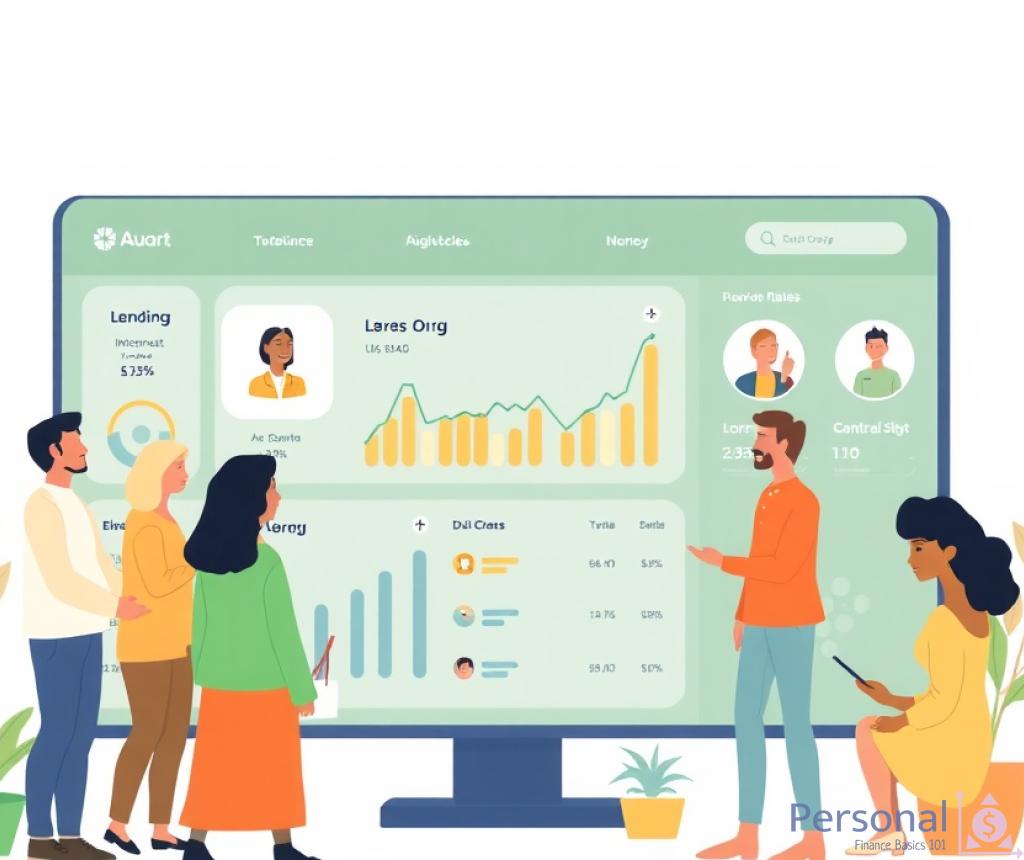Understanding Peer-to-Peer Lending

In recent years, traditional financial institutions have been challenged by innovative alternatives, one of the most prominent being Peer-to-Peer (P2P) lending. This model has gained traction, particularly for individuals seeking debt consolidation options. By directly connecting borrowers with individual lenders, P2P lending platforms have revolutionized the borrowing landscape.
Peer-to-peer lending platforms operate online, allowing borrowers to post their loan requests and lenders to fund them directly. This eliminates the need for a financial intermediary, often resulting in lower interest rates for borrowers and higher returns for lenders. As this trend continues to grow, understanding its mechanics is crucial for those considering this alternative borrowing solution.
The operational structure of P2P lending is relatively straightforward yet highly effective. Borrowers submit loan requests detailing the amount they wish to borrow and the purpose, which often includes debt consolidation. Lenders then review these requests and decide whether to fund the loans based on the borrower’s creditworthiness and the projected return on investment.
Several key players are involved in this process:
- Borrowers: Individuals seeking loans, often for debt consolidation or major purchases.
- Lenders: Individuals or institutional investors who provide the funds.
- P2P Platforms: Online services that facilitate the connection between borrowers and lenders.
By utilizing sophisticated algorithms, P2P platforms assess the risk profile of borrowers, which helps lenders make informed decisions.
While P2P lending offers numerous benefits, potential borrowers should be mindful of certain considerations. Below is a comparative overview that highlights the advantages and factors to weigh before engaging in P2P lending:
| Advantages | Considerations |
|---|---|
| Lower Interest Rates: Often more competitive than traditional banks. | Risk of Default: Borrowers may default, impacting lenders’ returns. |
| Flexible Terms: Borrowers can find loans that fit their financial situation. | Variable Returns: Lenders may experience fluctuating returns based on borrower performance. |
| Quick Access to Funds: The application process is typically faster than traditional banks. | Lack of Regulation: Less regulatory oversight compared to conventional lending. |
Understanding these elements is essential for both borrowers and lenders to make informed decisions about utilizing P2P lending for debt consolidation.
Advantages of Peer-to-Peer Lending for Debt Consolidation
In an era where financial independence is increasingly valued, many individuals are discovering the profound benefits of utilizing Peer-to-Peer (P2P) lending for debt consolidation. This innovative approach not only empowers borrowers to regain control over their financial situations but also presents an attractive opportunity for lenders seeking to maximize their investment returns. By fostering a direct connection between parties, P2P lending is reshaping how we view and manage debt.
Cost-Effective Solutions: One of the most compelling advantages of P2P lending is the potential for significantly lower interest rates compared to traditional lenders. With reduced overhead costs and the elimination of intermediaries, P2P platforms can offer competitive rates that are often more appealing, particularly for those looking to consolidate high-interest debts. This aspect can lead to substantial savings over time, allowing borrowers to pay off their debts more efficiently and improve their overall financial health.
Furthermore, P2P lending provides a level of customization that traditional banking institutions may lack. Borrowers are often able to negotiate terms that suit their unique financial situations, including flexible repayment schedules and varying loan amounts. This adaptability is particularly beneficial for individuals who may struggle to meet rigid repayment plans imposed by conventional lenders.
Streamlined Access to Capital: The speed at which funds can be accessed is another key advantage of P2P lending platforms. Unlike traditional banks that may require extensive paperwork and extended approval times, P2P platforms typically offer a more streamlined application process. Borrowers can expect quicker decisions and faster fund disbursements, which is crucial for those in urgent need of financial relief.
Moreover, the transparent nature of P2P lending fosters a sense of trust and accountability between borrowers and lenders. Both parties can review each other’s profiles and financial histories, which promotes informed decision-making. Lenders can assess the risk associated with potential borrowers while borrowers gain insights into the lender’s reliability and terms.
Risks Associated with Peer-to-Peer Lending
As the landscape of borrowing continues to evolve, Peer-to-Peer (P2P) lending emerges as an appealing alternative for many individuals seeking debt consolidation. However, while the benefits are well-documented, it is equally important to address the risks that accompany this lending model. Understanding these risks can empower both borrowers and lenders to make informed choices, ensuring a secure and beneficial experience.
One of the foremost concerns for borrowers in the P2P lending space is the risk of default. Borrowers must recognize that the absence of stringent credit checks, which are often present in traditional banking systems, can lead to situations where less creditworthy individuals secure loans. This scenario not only jeopardizes the financial stability of the borrower but also poses a significant threat to lenders, who may find themselves with unpaid loans. Default rates can vary widely across different platforms, making it essential for both parties to conduct thorough research and assess the platform’s historical performance and borrower profiles.
Moreover, the lack of regulatory oversight within the P2P lending environment adds another layer of complexity. Unlike conventional lenders, P2P platforms operate with minimal regulation, which can lead to inconsistencies in practices and protections across different platforms. Borrowers and lenders alike should be cautious and evaluate the credibility and reputation of the lending platform before engaging in any financial agreements. It is crucial to understand the terms and potential risks involved, as well as to ensure that the platform adheres to best practices in borrower evaluation and loan management.
Lastly, the variability of returns presents a unique challenge for lenders. The prospect of earning attractive interest rates is certainly appealing, but it is important to acknowledge that these returns are not guaranteed. The performance of loans can fluctuate based on various factors, including economic conditions and borrower behaviors. Lenders must be prepared for the possibility of losing a portion or all of their investment, particularly in cases where borrowers default.
In conclusion, while Peer-to-Peer lending offers an innovative approach to debt consolidation, it is imperative for participants to weigh the risks against the potential rewards. A thorough understanding of the inherent risks can lead to more strategic decision-making, ultimately enhancing the overall experience in this evolving financial landscape.
How to Choose the Right P2P Lending Platform
As the Peer-to-Peer (P2P) lending landscape continues to evolve, choosing the right platform for debt consolidation becomes a pivotal decision for borrowers. With numerous options available, it’s crucial to understand the essential factors that differentiate one platform from another. A well-informed choice not only enhances the likelihood of securing favorable loan terms but also ensures a smoother borrowing experience in the long run.
The credibility of a P2P lending platform is paramount. Before proceeding, borrowers should conduct thorough research into the platform’s reputation. This can be achieved by reading user reviews, checking ratings on independent financial websites, and exploring forums dedicated to personal finance. A platform that has a history of positive borrower experiences and transparent practices is likely to provide a more reliable service. Additionally, take note of any complaints or legal issues, which can provide insight into potential red flags.
When considering different P2P lending platforms, analyzing the fee structure and interest rates is essential. Fees can vary significantly between platforms and may include origination fees, late payment penalties, and servicing fees. It’s vital to review these costs carefully, as they can significantly impact the overall cost of the loan. Furthermore, interest rates should be compared not only to each other but also to traditional lending options to ensure that the P2P platform offers a competitive advantage. Borrowers should seek platforms that provide a clear breakdown of fees and transparent interest rate calculations.
Another critical factor is the flexibility of loan terms offered by the platform. Different P2P lending platforms may provide various repayment schedules, loan amounts, and terms, which can affect a borrower’s ability to manage their debt effectively. Look for platforms that allow for customizable repayment options, enabling borrowers to select terms that align with their financial capabilities and goals. Understanding the implications of fixed versus variable interest rates can also help in making a more informed choice.
In summary, the process of selecting the right P2P lending platform for debt consolidation demands careful consideration of various factors, including the platform’s reputation, fee structures, and loan terms. By taking the time to evaluate these elements, borrowers can enhance their chances of finding a suitable lending partner that meets their specific financial needs.
The Impact of Credit Scores on P2P Lending
As the popularity of Peer-to-Peer (P2P) lending continues to rise, understanding the role of credit scores becomes imperative for both borrowers and lenders. Credit scores serve as a crucial metric in determining an individual’s creditworthiness and can significantly influence the borrowing experience on P2P platforms. While these platforms aim to democratize access to loans, the implications of credit scores can vary from one platform to another, shaping the overall landscape of P2P lending for debt consolidation.
For borrowers, a credit score acts as a double-edged sword. On one hand, a high credit score can unlock better loan terms, including lower interest rates and increased borrowing limits. On the other hand, a low credit score may limit options, forcing borrowers to accept higher rates or even disqualifying them from certain platforms altogether. As such, it is essential for potential borrowers to understand how their credit score impacts their chances of securing favorable loan conditions.
P2P lending platforms utilize credit scores as part of their risk assessment processes, helping lenders gauge the likelihood of a borrower defaulting on a loan. Different platforms may weigh credit scores differently, with some focusing heavily on this metric while others may incorporate additional factors such as income verification, employment history, and debt-to-income ratios. This variability means that borrowers with similar credit scores may receive different offers based on the platform they choose.
For lenders, understanding the importance of credit scores can lead to more informed investment decisions. A thorough analysis of a borrower’s credit history can provide valuable insights into potential risks and returns. By evaluating these scores along with other financial indicators, lenders can build a more comprehensive picture of the borrower’s financial health.
Considering the implications of credit scores in P2P lending, it is beneficial for borrowers to be aware of the key factors that influence their credit ratings. The following list outlines the primary components affecting credit scores:
- Payment History: Timely payment of debts is crucial, as missed payments can significantly lower scores.
- Credit Utilization: Maintaining a low balance relative to credit limits is favorable for credit scores.
- Length of Credit History: A longer credit history can positively impact scores, showcasing responsible credit management.
- Types of Credit: A mix of credit types (e.g., credit cards, installment loans) can enhance scores.
- Recent Credit Inquiries: Frequent credit inquiries can negatively affect scores, signaling potential financial distress.
In conclusion, credit scores play a pivotal role in the realm of P2P lending for debt consolidation. Both borrowers and lenders must recognize the significance of these scores and the broader implications they carry. By understanding how credit scores impact borrowing opportunities and investment decisions, participants in the P2P lending arena can navigate this innovative financial landscape with greater confidence.
Disclaimer
This article has been created or edited with the support of artificial intelligence and is for informational purposes only. The information provided should not be considered investment advice. Please seek the support of a professional advisor before making any investment decisions.






